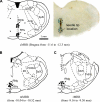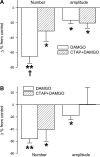Activation of opioid micro-receptors in medullary raphe depresses sighs
- PMID: 19244586
- PMCID: PMC2689826
- DOI: 10.1152/ajpregu.90748.2008
Activation of opioid micro-receptors in medullary raphe depresses sighs
Abstract
Sighs, a well-known phenomenon in mammals, are substantially augmented by hypoxia and hypercapnia. Because (d-Ala(2),N-Me-Phe(4),Gly-ol)-enkephalin (DAMGO), a mu-receptor agonist, injected intravenously and locally in the caudal medullary raphe region (cMRR) decreased the ventilatory response to hypoxia and hypercapnia, we hypothesized that these treatments could inhibit sigh responses to these chemical stimuli. The number and amplitude of sighs were recorded during three levels of isocapnic hypoxia (15%, 10%, and 5% O(2) for 1.5 min) or hypercapnia (3%, 7%, and 10% CO(2) for 4 min) to test the dependence of sigh responses on the intensity of chemical drive in anesthetized and spontaneously breathing rats. The role of mu-receptors in modulating sigh responses to 10% O(2) or 7% CO(2) was subsequently evaluated by comparing the sighs before and after 1) intravenous administration of DAMGO (100 microg/kg), 2) microinjection of DAMGO (35 ng/100 nl) into the cMRR, and 3) intravenous administration of DAMGO after microinjection of d-Phe-Cys-Tyr-d-Trp-Arg-Thr-Pen-Thr-NH(2) (CTAP, 100 ng/100 nl), a micro-receptor antagonist, into the cMRR. Hypoxia and hypercapnia increased the number, but not amplitude, of sighs in a concentration-dependent manner, and the responses to hypoxia were significantly greater than those to hypercapnia. Systemic and local injection of DAMGO into the cMRR predominantly decreased the number of sighs, while microinjection into the rostral and middle MRR had no or limited effects. Microinjecting CTAP into the cMRR significantly diminished the systemic DAMGO-induced reduction of the number of sighs in response to hypoxia, but not to hypercapnia. Thus we conclude that hypoxia and hypercapnia elevate the number of sighs in a concentration-dependent manner in anesthetized rats, and this response is significantly depressed by activating systemic mu-receptors, especially those within the cMRR.
Figures








Similar articles
-
Activation of opioid mu receptors in caudal medullary raphe region inhibits the ventilatory response to hypercapnia in anesthetized rats.Anesthesiology. 2007 Aug;107(2):288-97. doi: 10.1097/01.anes.0000270760.46821.67. Anesthesiology. 2007. PMID: 17667574
-
Opioid mu-receptors in medullary raphe region affect the hypoxic ventilation in anesthetized rats.Respir Physiol Neurobiol. 2009 Sep 30;168(3):281-8. doi: 10.1016/j.resp.2009.07.015. Epub 2009 Jul 24. Respir Physiol Neurobiol. 2009. PMID: 19632358 Free PMC article.
-
Activation of opioid μ-receptors in the commissural subdivision of the nucleus tractus solitarius abolishes the ventilatory response to hypoxia in anesthetized rats.Anesthesiology. 2011 Aug;115(2):353-63. doi: 10.1097/ALN.0b013e318224cc1f. Anesthesiology. 2011. PMID: 21716092
-
The psychophysiology of the sigh: II: The sigh from the psychological perspective.Biol Psychol. 2022 Sep;173:108386. doi: 10.1016/j.biopsycho.2022.108386. Epub 2022 Jul 6. Biol Psychol. 2022. PMID: 35803439 Review.
-
The psychophysiology of the sigh: I: The sigh from the physiological perspective.Biol Psychol. 2022 Apr;170:108313. doi: 10.1016/j.biopsycho.2022.108313. Epub 2022 Mar 11. Biol Psychol. 2022. PMID: 35288214 Free PMC article. Review.
Cited by
-
On the g-protein-coupled receptor heteromers and their allosteric receptor-receptor interactions in the central nervous system: focus on their role in pain modulation.Evid Based Complement Alternat Med. 2013;2013:563716. doi: 10.1155/2013/563716. Epub 2013 Jul 17. Evid Based Complement Alternat Med. 2013. PMID: 23956775 Free PMC article.
-
Respiratory Depression Associated with Opioids: A Narrative Review.Curr Treat Options Oncol. 2024 Nov;25(11):1438-1450. doi: 10.1007/s11864-024-01274-5. Epub 2024 Oct 21. Curr Treat Options Oncol. 2024. PMID: 39432171 Review.
-
Locus Coeruleus as a vigilance centre for active inspiration and expiration in rats.Sci Rep. 2018 Oct 23;8(1):15654. doi: 10.1038/s41598-018-34047-w. Sci Rep. 2018. PMID: 30353035 Free PMC article.
-
A novel, non-invasive method of respiratory monitoring for use with stereotactic procedures.J Neurosci Methods. 2012 Aug 15;209(2):337-43. doi: 10.1016/j.jneumeth.2012.06.029. Epub 2012 Jul 4. J Neurosci Methods. 2012. PMID: 22771713 Free PMC article.
References
-
- Aicher SA, Goldberg A, Sharma S, Pickel VM. Mu-opioid receptors are present in vagal afferents and their dendritic targets in the medial nucleus tractus solitarius. J Comp Neurol 422: 181–190, 2000. - PubMed
-
- Ballantyne JC, Carr DB, deFerranti S, Suarez T, Lau J, Chalmers TC, Angelillo IF, Mosteller F. The comparative effects of postoperative analgesic therapies on pulmonary outcome: cumulative meta-analyses of randomized, controlled trials. Anesth Analg 86: 598–612, 1998. - PubMed
-
- Bartlett D Jr. Origin and regulation of spontaneous deep breaths. Respir Physiol 12: 230–238, 1971. - PubMed
-
- Bendixen HH, Smith GM, Mead J. Pattern of ventilation in young adults. J Appl Physiol 19: 195–198, 1964. - PubMed
-
- Bisgar GE, Neubauer JA. Peripheral and central effects of hypoxia. In: Regulation of Breathing, edited by Dempsey JA, Pack AL. New York: Dekker, 1995, p. 617.
Publication types
MeSH terms
Substances
Grants and funding
LinkOut - more resources
Full Text Sources
Research Materials

